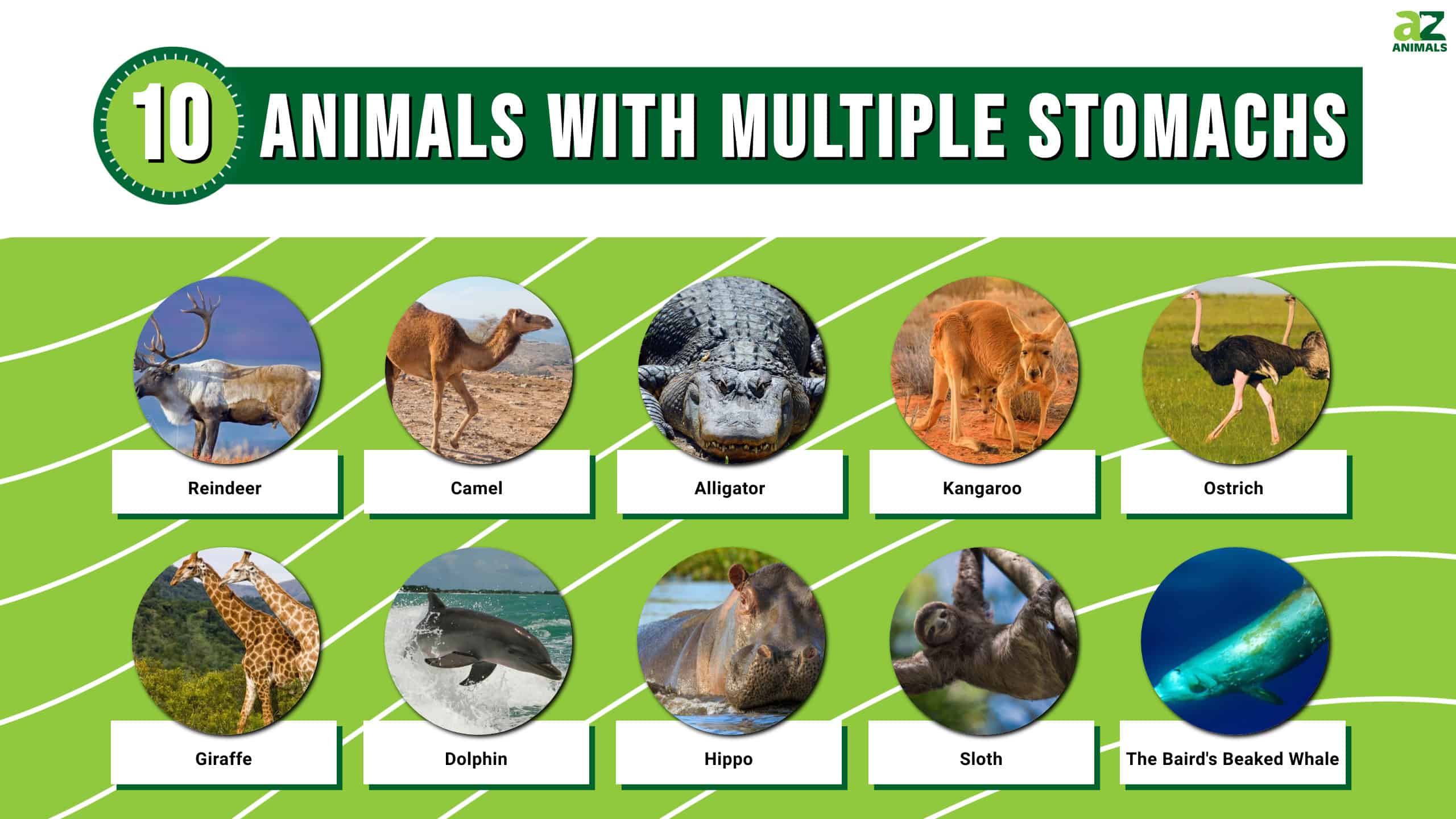
There are millions of species of animals in the world today and, no matter whether they are on the land or in the water, eating is one of the most important things for all of them. Many animals have unique digestive systems that suit their eating habits and environment, and lots have several stomachs, with each one having a different essential role. Here we’ll discover some of the animals that have multiple stomachs and exactly how they work.
Reindeer

As ruminants reindeer have four stomachs
©Jeff McGraw/Shutterstock.com
Reindeer are herbivorous mammals that are native to Alaska, Canada, Greenland, northern Europe, and northern Asia. They are characterized by their grey-brown fur and antlers. In many areas reindeer are used a source of food, milk, and transportation for people. However, brown bears, polar bears, and wolves often prey on reindeer. Combined with over-hunting, reindeer populations are under threat and they are classed as a vulnerable species.
Reindeer, like all other members of the deer family, are ruminants. Ruminants have four stomachs and “chew the cud”. This means that they first chew their food enough to swallow it so it can be stored in the first stomach (the rumen). It is then broken down further in the second stomach (the reticulum) before they burp up food from this stomach back into their mouth to be chewed further. This is often done while they are resting and is called chewing the cud. Once swallowed again, the food goes into the third stomach (the omasum) where water is absorbed. Finally, it is sent to the abomasum to be further broken down before it is sent to the intestines where nutrients are absorbed into the body.
Camel

Camels have adapted perfectly to life in the desert
©Fabian Junge/Shutterstock.com
Camels are distinctive animals that are most noted for the humps on their backs and their ability to survive in the harsh desert conditions of Africa and the Middle East. There are three species alive today – the dromedary (single hump), Bactrian (two humps), and Wild Bactrian (also two humps). Camels have been domesticated for many years and are a vital method of transportation in deserts. Camels have adapted to the hot environment in many ways, including surviving without water for many days. They do this by storing fatty tissue in their humps which can be metabolized into water. Camels, like other camelids (alpacas and llamas) have three stomachs. These chambers allow them to absorb as many nutrients as possible from the scarce and poor food that they eat.
Alligator
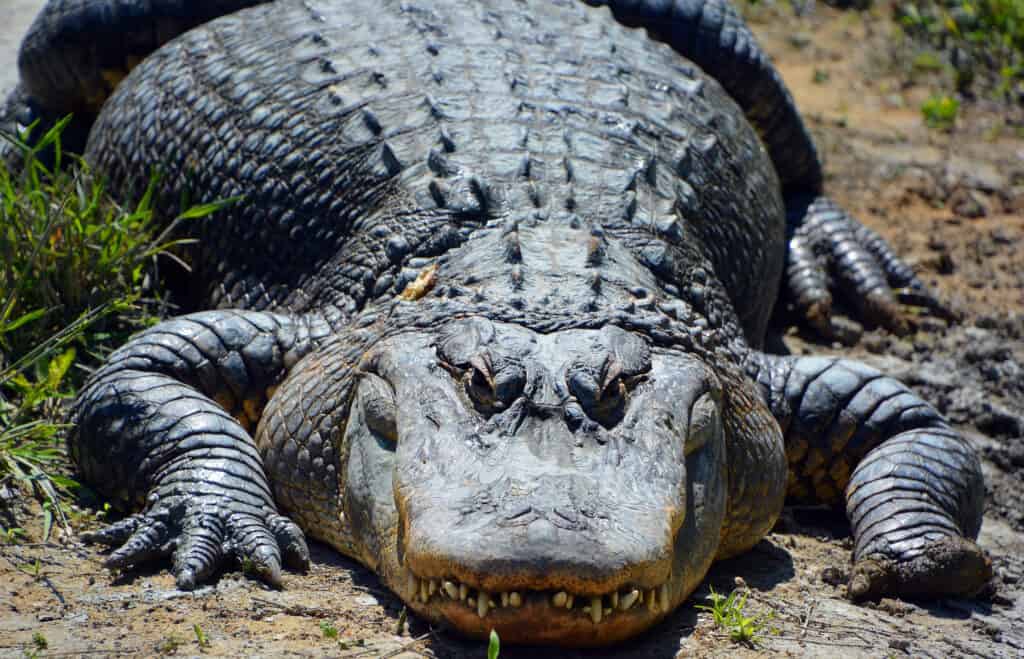
Alligators have two stomachs.
©meunierd/Shutterstock.com
Alligators are large carnivorous reptiles that are native to the US, Mexico, and China where they are found in freshwater lakes, rivers, and swamps. They are usually black or greenish brown with white undersides and the most noticeable difference between them and crocodiles is their snout shape. Alligators have a much shorter and more rounded snout than crocodiles who have a slender and pointier snout. They have immense strength in their snout which allows them to crush prey such as turtles and small mammals. Alligators have two stomachs which they use to digest their prey. The first part contains gastroliths (stones) to grind up the meal, while the second part is extremely acidic to break down the rest of the food so that they can digest it.
Kangaroo
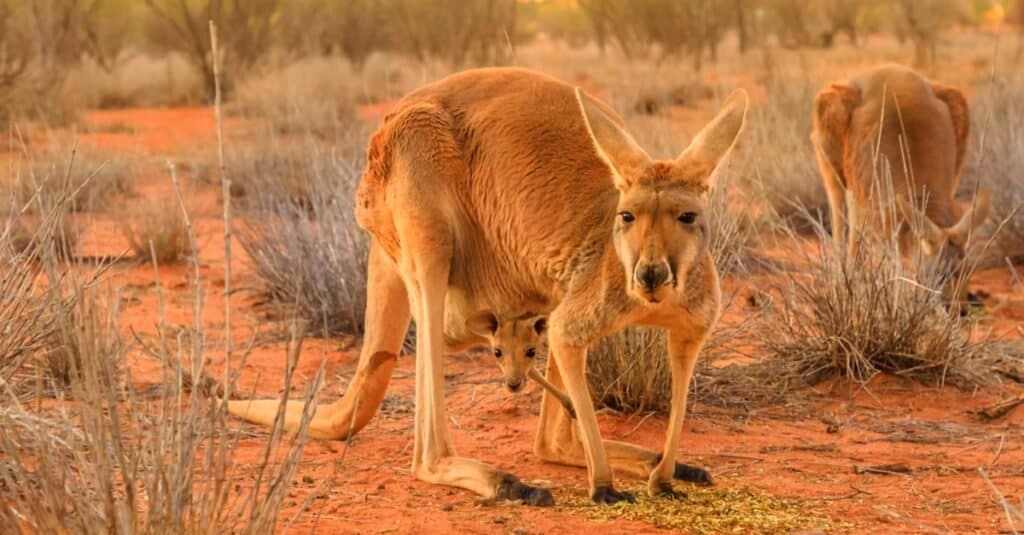
Kangaroos only have two stomachs
©Benny Marty/Shutterstock.com
Kangaroos are the four largest species in the family group Macropodidae. They are marsupials that are native to Australia and New Guinea and they have two stomach chambers. Kangaroos are herbivores and graze mostly on grass and sometimes shrubs. Although they do regurgitate food and chew it again, they don’t chew the cud as often as ruminants as it is more difficult for them. Kangaroos are easily recognized by their distinctive hopping gait which is made possible by their powerful back legs and long tail. Incredibly, the largest kangaroos can reach a height of 8 feet and a top speed of 43 mph. Males often “box” by wrestling with each other and balancing on their tails while kicking each other in the abdomen with their back legs. Many of the natural predators of kangaroos are now extinct, but surviving ones include dingos, eagles, and goannas.
Ostrich

Unusual animals – ostriches eat stones to help break down their food
©Cristian Zamfir/Shutterstock.com
Ostriches are large, flightless birds which are native to Africa. They are also the fastest birds on land and are capable of reaching 43 mph. There are two existing species of ostrich – the common ostrich and the Somali ostrich – and both can reach heights of around 9 feet. Ostriches have small heads, long necks, and long legs. Males are black, while females are grey and brown and both have white wings and tails. Ostriches usually live in the savanna and desert regions and eat mixture of seeds, grass, shrubs, insects, and small lizards.
Ostriches have three stomachs and are particularly unusual as they have an extremely long intestine. They don’t have teeth so they eat small stones to help grind down their food. Therefore, they need three stomachs so that they can break down all of the different things that they eat. The ventriculus is the stomach where they store stones and pebbles to grind their food with. Some ostriches even carry around 2 pounds of stones in there.
Giraffe

Giraffes eat mainly acacia leaves
©NelisNienaber/Shutterstock.com
Giraffes are the tallest animal alive in the world today and also the largest ruminant. These majestic animals are native to Africa and there are nine subspecies. Giraffes are easily recognized by their long necks and distinctive tan and white coat with its unique pattern. They can reach the incredible height of 20 feet which enables them to reach leaves at the tops of trees where other animals can’t. Giraffes live in the savannahs and open woodland areas where they prefer to eat from acacia trees. They have four stomach chambers, and the first chamber has adapted to their predominantly acacia diet. Giraffes spend most of the day eating and consume around 75 pounds of leaves per day. As they are ruminants, they frequently burp up semi-digested food to chew it over again, often for hours at a time.
Giraffes live in groups that usually consist of adult females and young, with the males in separate bachelor herds. Survival rate is good in adults, with most having a lifespan of towards 38 years. Due to their size and powerful hindlegs that can deliver a lethal kick to a predator, adults are generally only preyed on by lions. However, leopards, hyenas, and wild dogs often prey on calves, with only around a half reaching adulthood. Sadly, giraffes are in decline and they are classed as vulnerable, although several subspecies are endangered.
Dolphin

Most dolphins have three stomachs
©iStock.com/Brian Sevald
Dolphins are highly intelligent aquatic mammals that are found right across the world. There are 40 species of dolphin and they are found in every ocean, and there are even some that live in freshwater rivers. They range in size from species that are around 6 feet long to the 31-foot-long killer whale which is actually a member of the dolphin family. Dolphins are can dive to around 1,000 feet and they feed on a range of fish, squid, and crustaceans. Most dolphins have three stomachs, but some only have two. As dolphins don’t chew their food, the first stomach takes care breaking it down into smaller pieces, while the rest of the digestion takes place in the second and third stomachs.
Hippo

Hippos are pseudo-ruminants
©Radek Borovka/Shutterstock.com
Hippos are large, semi-aquatic mammals that are native to Africa and are the third-largest land mammal in the world. They have a distinctive appearances with a round body on short legs and a large head with impressive canine tusks. Hippos live around lakes, rivers, and swamps and spend much of their time in the mud and water to stay cool. They are excellent swimmers and, amazingly, they sometimes even give birth in the water. Hippos eat mainly grass, although they also raid crops. They have a particularly unique digestive system as they are known as “pseudo-ruminants”. Pseudo-ruminants have three stomachs, but still have the same benefits of a four chambered ruminant stomach. This means that their stomachs break down their food in each compartment without them needing to chew the cud like ruminants do.
Sloth
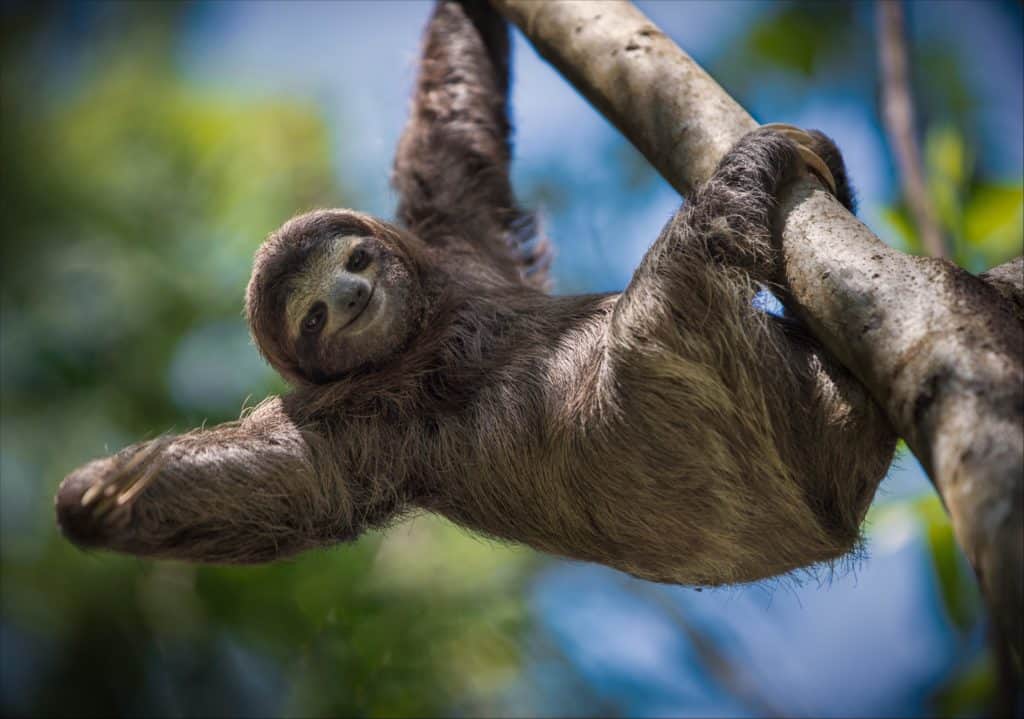
Sloths have the lowest metabolic rate of any animal.
©jdross75/Shutterstock.com
Sloths are tree-dwelling mammals that are native to Central and South America where they can be found in tropical rainforests, often hanging upside down. These adorable creatures have thick, brown fur and are most famous for being exceptionally slow – they travel through the trees at a rate of only 40 yards per day. Incredibly, despite being almost helpless when on the ground, sloths can actually swim and enjoy going for a paddle. However, it’s not just their speed that is slow, as sloths have the lowest metabolic rate of any animal. This means that it takes them an extremely long time to digest anything. Leaves are their main source of food and don’t provide much energy or nutrients. They also don’t digest easily, which is why sloths have four stomachs to fully break them down. The entire process takes around a month to complete.
The Baird’s Beaked Whale (It has 13 stomachs!)
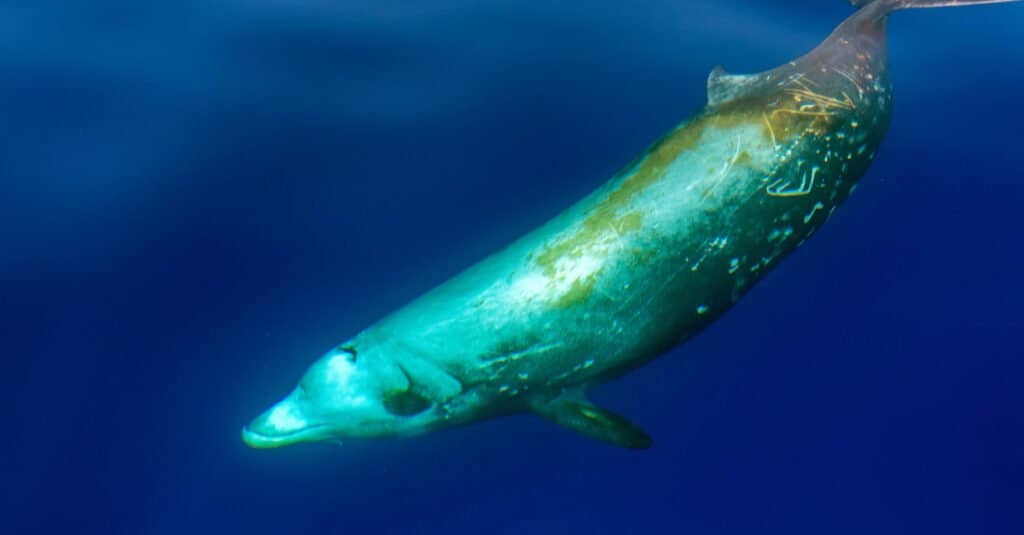
A beaked whale can have up to 13 stomachs!
©Andrea Izzotti/Shutterstock.com
Topping our list of animals with multiple stomachs is the Baird’s beaked whale, which can have more than 13 stomachs! How is this possible? The whale has two large stomach chambers, its main stomach and a pyloric stomach. Then beaked whales have a series of connecting chambers between stomachs. Research found the mean number of connecting chambers in beaked whales was 8.24. However, different animals have different numbers of connecting chambers, with researchers finding anywhere from 3 to 11 connecting stomach chambers in different whales. That is to say, when including its two main stomachs, some Baird’s beaked whales have up to 13 stomachs!
What Animal Has 800 Stomachs?
You’d be surprised at how many animals have multiple stomachs. But there’s a question circulating around the internet about an animal that has been said to have 800 stomachs. This minuscule creature that has attained legendary status is the Etruscan shrew. So is it true? In a word–no. While the number 800 can be attributed to the Etruscan shrew, it’s not for its stomachs, but rather, its heartbeats. Etruscan shrew hearts beat between 800 and 1000 times a minute. Now that is something to marvel at.
There are many other animals with multiple stomachs we didn’t cover. Here are a few more listed below:
- Goats–4 stomachs
- Sheep–4 stomachs
- Cattle–4 stomachs
- Deer–4 stomachs
- Buffaloes & Bison–4 stomachs
- Antelope–4 stomachs
- Yaks–4 stomachs
- Manatees–4 stomachs
- Llamas and Alpacas–3 stomachs
Summary Of 10 Animals With Multiple Stomachs
| # | Animal | Number Of Stomachs |
|---|---|---|
| 1 | Reindeer | 4 |
| 2 | Camel | 3 |
| 3 | Alligator | 2 |
| 4 | Kangaroo | 2 |
| 5 | Ostrich | 3 |
| 6 | Giraffe | 4 |
| 7 | Dolphin | 2 or 3 |
| 8 | Hippos | 3 |
| 9 | Sloth | 4 |
| 10 | The Baird’s Beaked Whale | Up to 13 |
The photo featured at the top of this post is © iStock.com/mesut zengin
Thank you for reading! Have some feedback for us? Contact the AZ Animals editorial team.






